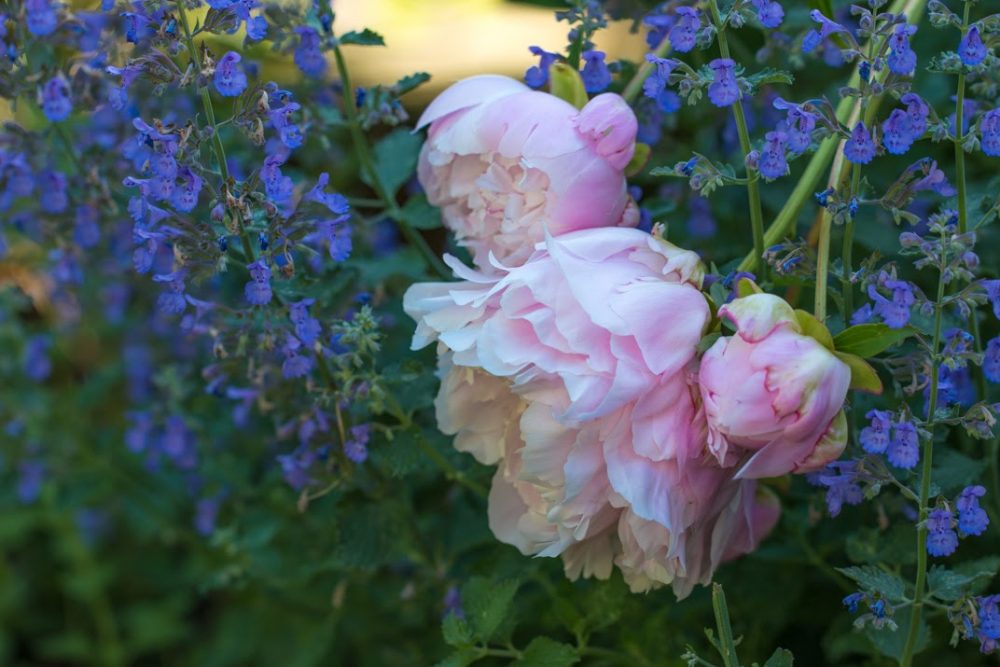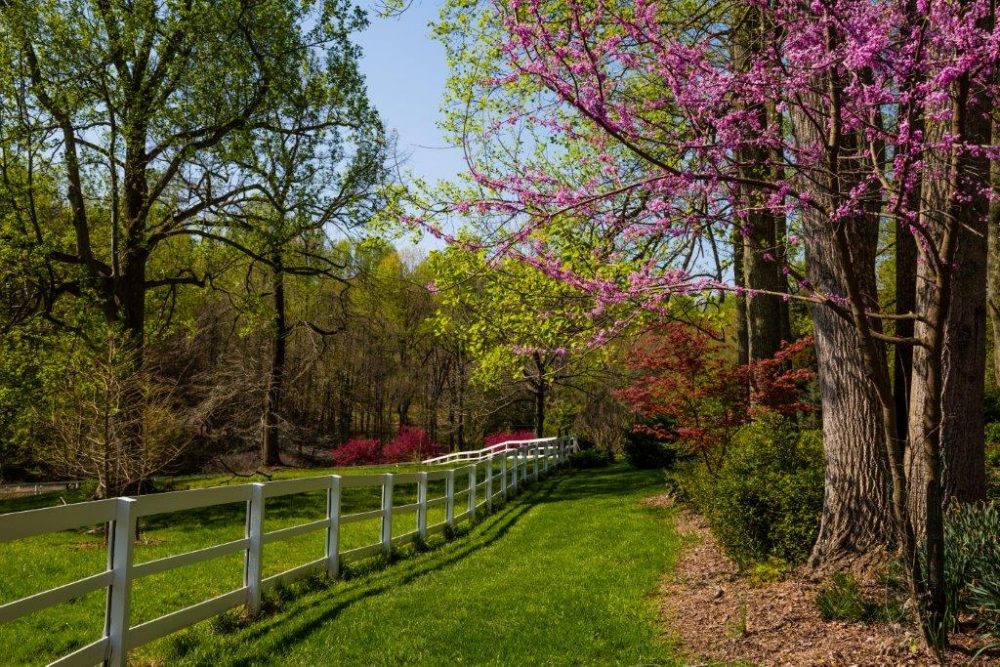
Offering a beauty and grace that defy formality, peonies are a favorite plant in Southern gardens. Here, they are planted among purple-blooming catmint.
What makes a garden quintessentially Southern? In Virginia the weather is mild enough that most of the year our living areas extend into our outdoor spaces. We love our bluestone patios and our screened-in porches. For me, there is nothing better than a garden walkabout, tea in hand if this ritual occurs in the morning, wineglass if it’s after work. Appreciating what has unfurled during the course of the day is a gift I give myself, especially in early spring. When tender bulbs poke up through mulched beds and chartreuse leaves appear on trees limbs, I know that Historic Garden Week is on its way.
Even formal gardens in the South have a charming informality. A peony border just can’t help itself; it flops and nods like a petulant teenager. Maybe our gardens reflect a regional penchant for exuberance. By the time Historic Garden Week kicks off in late April, Virginia is swathed in bloom. Budding branches, flowering shrubs, and jewel-toned tulips provide splashes of color, reminding us of the marvel of renewed life that is the spring.

Spring is a wonderful time for a garden walkabout at Clifton-Fairfax Station, near Virginia hunt country.
I sat down with Wendy Walker, Horticulture Chairman of the Garden Club of Virginia, to talk about plants that grow well in Southern gardens, especially those that work well in floral designs. One of the signatures of Historic Garden Week is the award-winning floral arrangements that decorate the featured homes. The Garden Club of Virginia, the event’s sponsor, estimates that up to 2,200 arrangements are created especially for tours and enjoyed by visitors.[/vc_column_text][vc_empty_space height=”16px”][vc_column_text]
“We really encourage our members to cut from their own, or their neighbors’ gardens. This is a way to highlight seasonal, garden-grown, and native plants.” — Wendy Walker, Horticulture Chairman, Garden Club of Virginia
[/vc_column_text][vc_empty_space height=”16px”][vc_column_text]The following flowers and foliage are those frequently requested by Garden Club of Virginia members for the event. “Anything that you believe is pretty, interesting, and useful will work well when properly prepped,” Walker says. “Remember to harvest your items in the cool morning or evening, ideally, and allow sufficient time for conditioning. A wide variety of plant material will allow your creative juices to flow. Of course, Mother Nature will dictate what we find.”
Plants for Southern Gardens & Floral Arrangements
Click the arrows (or swipe if on a mobile device) to see more

Azaleas
Shrubs are the defining element of a Southern garden. Azaleas create their own show in the spring and contribute to the colorful abundance of a cutting garden. Carefree and prolific, azaleas have two distinct genera, deciduous and evergreen, and can range from 2 to 12 feet tall. The twiggy form provides a casual elegance in arrangements. In Virginia, azaleas herald spring, covering the state in swaths of pink, red, magenta, and white.

Viburnum
“Blooming branches from small trees or shrubs, like weigelia, spirea, Kerria japonica, Scotch broom, and viburnum are popular with our arrangers,” Walker notes. Viburnum, in particular, is useful in both the landscape and floral design. Koreanspice viburnum has a strong, exotic scent, and is an excellent foundation plant and addition to the shrub border. Make sure to plant it somewhere where the scent will be appreciated. “Snowball viburnum is really popular with our arrangers too,” she continues. “It has the advantage of starting out lime green and then opening to pure white puff balls, giving it two completely different looks.” In the loose arrangement above, white viburnum flowers and a variety of coral-hued blooms play off the colors of a chinoiserie vase.

Natives, like Virginia Bluebell
Wildflowers are a great way to naturalize beds or borders in a Southern landscape. More popular than ever, they appeal to our regional pride. Many prefer the moist, rich soil and dappled shade of a woodland setting. When it comes to making a show, more is better. For impact, plant in sweeps rather than scattering in a wide area. “No one would dispute the simple beauty of natives, like the Virginia bluebell, one of our favorites, but their importance to the environment can’t be understated,” Walker says. “We encourage the planting of natives in the home garden.”

Branches in General
“You can create a towering arrangement very easily with the right branches.
Magnolia, Harry Lauder’s walking stick, pussy willow, Japanese maple, palm leaves, Russian olive, and horse chestnut are all great options if you have the space and want some drama,” Walker says. “Arrange them in a clear vase, and the stems become part of the overall design. Be sure to add a small amount of bleach or floral preservative to keep the water clear.” To ensure the intake of water by woody stems, pare off the bark from the bottom and crosscut the stems with your clippers.

Hosta
Tough, handsome and shade-loving, hostas are primarily grown for their leaves. One of our favorite additions to an arrangement, their tear-dropped shaped foliage is especially suited for the perimeter whether in a vase or a bouquet. “Hostas are practically a salad bar if you have a deer problem, but they are the perfect companion to follow bulbs such as daffodils and tulips because their growth habit hides the fading leaves,” Walker points out. Other greenery, such as fatsia, ferns, poet’s laurel, euphorbia and even rosemary, are excellent in arrangements.

Hydrangea
These old-fashioned favorites are dependable, and when properly prepped, long lasting. The French hydrangea, a standard in the South, thrives in the heat of the summer. It is prized both inside and outside for producing one of the showiest and truest blue flowers, but it also comes in pink, white, and nearly red. “They are so easy to work with, it only takes a few to look great in an arrangement,” Walker says. “They have those wonderful mop-headed pom-poms along with a graceful limb habit and pretty green leaves. As long as they are
conditioned correctly so they can drink plenty of water, they always reward.”
Discover more hydrangea varieties for your garden.

Hellebores
For those who enjoy cutting from your own garden and arranging,
hellebores, or Lenten Roses, require special conditioning, or they will droop too much to last more than a few hours. “I’m still learning how to condition these unusual flowers for longevity in a vase, but so far, the trick seems to be to cut them after the stamens have transitioned to seed heads, which normally aligns with Historic Garden Week,” Walker shares. After cutting the fibrous stems, cauterize them with a lighter before using them in arrangements. One of the easiest to grow perennial ground covers available, hellebores now come in lots of different colors and forms and are deer resistant and self-seed unabashedly. “They do require a bit of tidying up in late winter so they will look their best at bloom time, but this is a simple chore.” Pictured above, graceful, pale green hellebore blooms add texture and seasonal interest in an arrangement of peonies and smaller white flowers.

Tulips
The Queen Bee of the spring garden, tulips offer all sorts of sizes, shapes, and colors and are tolerant of late planting. “Depending on the weather in Virginia, we’ve found planting bulbs as late as December tricks them into blooming during Historic Garden Week,” Walker says. “Several years ago, I started buying the sorry-looking, on-sale pansies at the end of the fall season and using them as markers for bulb plantings. Not only do these living placeholders help me avoid slicing through bulbs when I start transplanting seedlings, but they get full and glorious in the spring, creating an ideal carpet for bulbs.”
See more tips for growing and cutting tulips.

Peonies
These voluptuous beauties seem to be everyone’s favorites, especially tree peonies. “They are so stunning that sometimes our arrangers will use just a single bloom to make an elegant and dramatic statement in a vase,” Walker notes. Most varieties of peonies have very large blooms with multiple petals and can become top heavy. Cut the stems so that they are not too tall in the vase, allowing the sides of the vase to help support the stems as the peonies start to open. Peonies are big drinkers. Check the water level daily as you might need to add fresh water. Cut when they are in a “squishy ball” phase to lengthen your enjoyment of the cut flowers. “What does that mean? It means it feels like a marshmallow when gently squeezed,” Walker says.

Solomon’s Seal
This graceful plant with stems as long as 2 feet adds texture to a woodland garden and architecture to an arrangement. “It’s one of the first plants our new members typically add to their own gardens after they see how versatile it is in Historic Garden Week arrangements,” Walker tells us. Shade is a part of the Southern garden, and these arching stems with pendulous dangling white flowers are the perfect foil to frothy ferns and clumpy hostas. Arranging with just greenery is simple and easy. “Nothing does more than cut green foliage to freshen up a room at minimum expenditure of both time and money,” Walker says.

Dogwood
“One of the most beautiful natives and the state flower of Virginia, Cornus florida, the flowering dogwood, is ideal as a lawn specimen,” Walker points out, “especially when underplanted with spring-flowering bulbs or shade-loving perennials like bleeding hearts, astilbe, and hosta.” Another favorite pairing is dogwood and hydrangea. With its early spring blooms, dogwood provides an understory to tall trees, and hydrangeas provide an understory to the dogwood.

Daffodils
These harbingers of spring are often planted where they can be left to naturalize, such as under the light shade of a tree or in a woodland garden. In mixed beds or borders, the faded foliage will be hidden by the summer foliage of other plants. Typical companions in a Southern garden are hostas and daylilies. After cutting daffodils, condition them separately for at least six hours before mixing with other flowers in your arrangement. Daffodils give off a sap that can be deadly to other flowers and is one of the reasons that deer avoid them. Pictured above, daffodil fields at Eyre Hall in Northampton, Virginia.

Lily of the Valley
These dainty flowers demand little fuss in the garden and reward with an intoxicating perfume that makes a lovely little bouquet with no effort at all. If the scent of a gardenia is the smell of the South in summer, these petite flowers announce an early spring in Virginia. “They are tougher than their fairy-like appearance, capable of withstanding challenges that would kill more timid ground covers, and their root system is dense, which means they crowd out most weeds,” Walker says. “Just make sure to plant them in partial shade, which they prefer, and somewhere where you will enjoy their perfume."
By Karen Cauthen Ellsworth, director of Virginia’s Historic Garden Week, vagardenweek.org | Photography courtesy of Garden Club of Virginia members Jane Cowles, Donna Moulton, Diane Ginsberg, Kimberly Wright, and Catriona Tudor Erler
For more news, web exclusives, and Flower magazine favorites in your inbox, sign up for our FREE newsletter.





